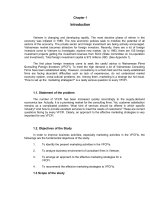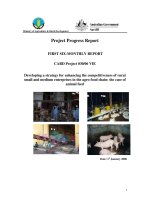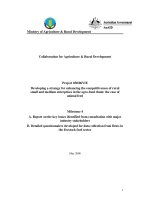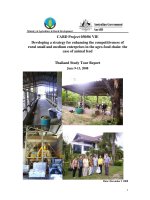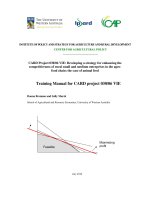Marketing strategy for FDI consulting services of investconsult group HCM branch
Bạn đang xem bản rút gọn của tài liệu. Xem và tải ngay bản đầy đủ của tài liệu tại đây (935.09 KB, 131 trang )
HCMC OPEN UNIVERSITY UNIVERSITÉ LIBRE DE BRUXELLES
SOLVAY BUSINESS SCHOOL
MASTER IN MANAGEMENT PROGRAM (MMVCFB 6)
NGÔ TH卯 VÂN QUNH
MARKETING STRATEGY
FOR FDI CONSULTING SERVICES OF
INVESTCONSULT GROUP – HCMC BRANCH
THESIS TUTOR : Assoc. Pro. Dr. NGUYEN DONG PHONG
MASTER IN MANAGEMENT THESIS
Ho Chi Minh City
2007
WARRANT STATEMENT
This is my original work. All data and results stated in the thesis are
completely true.
Ngô Th鵜 Vân Qunh
i
A
A
C
C
K
K
N
N
O
O
W
W
L
L
E
E
D
D
G
G
E
E
M
M
E
E
N
N
T
T
My deepest gratitude goes to my husband for his understanding, patience and
support throughout the MBA program and especially during these last months of
research and writing, when he had to take care of my kids and carry the family
burden share of my parts.
Special thanks to Associate Professor Doctor Nguyen Dong Phong, advisor of the
research for his advice, guidance and encouragement throughout the research study
Many thanks to the Open University – Solvay Business School program professors
and officers, who have helped me with all their kindness and warmest assistance
during the course.
Many thanks to InvestConsult Group and to my colleagues who always support and
give me valuable assistance and relevant data in the research. Many thanks to my
colleagues at Vision & Associate and FISC and to clients of InvestConsult-HCM,
who shared with me time and information for the relevant interviews.
Finally, many thanks also to all the professors, participants, friends and specially to
my loved, without them this research would not have been possible.
ii
T
T
A
A
B
B
L
L
E
E
O
O
F
F
C
C
O
O
N
N
T
T
E
E
N
N
T
T
S
S
CONTENTS PAGE
ACKNOWLEDGMENT (i)
TABLE OF CONTENTS (ii)
ABBREVIATIONS (viii)
LIST OF FIGURES AND TABLES (ix)
INTRODUCTION
1. PROBLEM CONTEXT 1
2. OBJECTIVES OF RESEARCH STUDY 2
3. SCOPE AND LIMITATION OF RESEARCH STUDY 2
4. METHODOLOGY 3
5. RESEARCH FRAMEWORK 4
6. STRUCTURE OF THE STUDY 5
CHAPTER 1
OVERVIEW ON SERVICE MARKETING AND THE MARKET OF FDI
CONSULTANCY SERVICES IN VIETNAM
1.1 AN INTRODUCTION TO SERVICES 7
1.1.1 Definition of Service 7
1.1.2 Characteristics of services and their marketing implications 7
iii
1.1.3 Role of services in economy 9
1.1.4 Services in the development of enterprises 10
1.2 AN INTRODUCTION OF SERVICE MARKETING 11
1.3 FDI CONSULTANCY MARKET IN VIETNAM 14
1.3.1 FDI consultancy service providers 15
1.3.2 Sketching out consumers of FDI consultancy services in Vietnam 17
1.3.3 FDI statistics in Vietnam 19
1.4 EXPERIENCE OF SOME COMPANIES IN PROVIDING FDI
CONSULTANCY SERVICES IN VIETNAM 21
1.4.1 Success experience 21
1.4.2 Failing experience 22
1.4.3 Lesson learned from success and failing experience 23
SUMMARY 24
CHAPTER 2
INTRODUCTION OF INVESTCONSULT GROUP – HCMC BRANCH AND
ITS FDI CONSULTANCY SERVICES
2.1 HISTORY AND DEVELOPMENT OF INVESTCONSULT GROUP 26
2.1.1 Establishment history 26
2.1.2 Vision and mission 27
2.1.3 Organization structure 27
iv
2.2 MAIN SERVICES OF INVESTCONSULT GROUP 28
2.2.1 Legal services 29
2.2.2 Intellectual property services 31
2.2.3. Investment project consultancy 33
2.2.4 Market research 34
2.3 FDI CONSULTANCY SERVICES OF INVESTCONSULT-HCM 35
2.3.1 Evaluation of the results on providing FDI consultancy services of
InvestConsult-HCM for the last three years 35
2.3.1.1 Business results of InvestConsult-HCM for the last three years 35
2.3.1.2 Total new FDI projects to which InvestConsult-HCM rendered
consultancy services for the last three years 37
2.3.1.3 Evaluation of clients on FDI consultancy services of
InvestConsult-HCM 38
2.3.2 Process for implementing FDI consultancy services of InvestConsult
-HCM 46
2.3.3 Marketing activities of InvestConsult-HCM to the FDI consultancy
market 49
2.3.3.1Market survey 49
2.3.3.2 Promotion activities of InvestConsult-HCM 50
2.3.3.3Expanding channels to attract more potential clients 53
2.3.4 Marketing organization at InvestConsult-HCM 54
v
2.3.5 SWOT Analysis on InvestConsult-HCM 55
2.3.5.1 Strengths 56
2.3.5.2 Weakness 57
2.3.5.3 Opportunities 57
2.3.5.4 Threats 58
SUMMARY 59
CHAPTER 3
MARKETING STRATEGY FOR FDI CONSULTANCY SERVICES OF
INVESTCONSULT GROUP – HCMC BRANCH
3.1 DEVELOPMENT TREND OF THE FDI CONSULTANCY MARKET IN
VIETNAM 61
3.2 OBJECTIVES OF THE MARKETING STRATEGY FOR FDI
CONSULTANCY SERVICES OF INVESTCONSULT-HCM 63
3.3 MARKETING-MIX STRATEGY FOR FDI CONSULTANCY SERVICES
OF INVESTCONSULT-HCM 64
3.3.1 Products 64
3.3.1.1Product categorization 65
3.3.1.2 Branding and differentiation 66
3.3.2 Pricing 68
3.3.2.1 Flexible policy in pricing 68
3.3.2.2 Special considerations of FDI consultancy service pricing 69
vi
3.3.2.3 Relationship pricing 71
3.3.3 Place 72
3.3.3.1 Location 73
3.3.3.2 Channels 73
3.3.4 Promotion 75
3.3.4.1 Advertising 76
3.3.4.2 Personal selling 78
3.3.4.3 Sales promotion 80
3.3.4.4 Public Relations 81
3.3.4.5 The associate environment and the networking 81
3.3.5 People 84
3.3.5.1 Differing roles of people 84
3.3.5.2 Internal marketing 86
3.3.5.3 Training 87
3.3.6 Process 89
3.3.7 Physical evidence 90
3.4 SOME SPECIFIC SOLUTIONS FOR IMPLEMENTING THE
MARKETING STRATEGY FOR FDI CONSULTANCY SERVICES OF
INVESTCONSULT-HCM 91
3.4.1 Marketing organization of InvestConsult-HCM 92
vii
3.4.2 Improving FDI promotion activities 95
3.4.3 Policy for human resource 96
SUMMARY 98
CHAPTER 4
CONCLUSION AND RECOMMENDATION
4.1 CONCLUSION 100
4.2 RECOMMENDATIONS 101
4.2.1 Having marketing approach to FDI attraction 101
4.2.2 Recognizing the role of consultancy companies in FDI attraction 102
4.2.3 Setting up a database system available to foreign investors and
business community 103
4.3 RECOMMENDATIONS FOR NEXT STUDIES 103
ANNEX A SURVEY QUESTIONNAIRE 105
ANNEX B SURVEY RESULTS 111
REFERENCES 118
viii
A
A
B
B
B
B
R
R
E
E
V
V
I
I
A
A
T
T
I
I
O
O
N
N
S
S
ASEAN Association of South East Asia Nations
FDI Foreign Direct Investment
GDP Gross Domestic Product
HCMC Ho Chi Minh City
Inco-HCM or
InvestConsult-HCM InvestConsult Group – HCMC Branch
MPI Ministry of Planning and Investment
PR Public Relation
SCCI State Committee of Co-operation and Investment (now MPI)
SME Small and Medium Enterprises
SWOT Strengths, Weaknesses, Opportunities, Threats
USBTA US-Vietnam Bilateral Trade Agreement
US or USA United States of America
USD/ US Dollar Official Currency of the United States of America
VDF Vietnam Development Forum
WTO World Trade Organization
ix
L
L
I
I
S
S
T
T
O
O
F
F
F
F
I
I
G
G
U
U
R
R
E
E
S
S
A
A
N
N
D
D
T
T
A
A
B
B
L
L
E
E
S
S
Figure 1.1: GDP structures of Vietnam in 2005 and 2006 9
Figure 1.2: Elements in a service encounter 12
Figure 1.3: Three types of marketing in service industry 13
Figure 1.4: FDI Statistics in Vietnam for the period 2001- 2006 19
Figure 2.1: Organization Chart of InvestConsult Group 28
Figure 2.2: Business results of InvestConsult Group for the last 03 years 36
Figure 2.3: FDI projects to which InvestConsult-HCM rendered consultancy
services 37
Figure 2.4: Statistical record of clients’ statements of InvestConsult-HCM 39
Figure 2.5: Statistical record of clients’ level of satisfaction 42
Figure 2.6: Statistical record of elements encouraging clients to use
InvestConsult-HCM’s services 43
Figure 2.7: Statistic opinion of clients about InvestConsult-HCM’s personnel .44
Figure 2.8: Statistic opinion of clients on recommending InvestConsult-
HCM’s services to others 45
Figure 2.9: Process for a foreign investor to get an investment license for its
project 47
Figure 2.10: Normal process for implementing FDI consultancy services 48
Figure 2.11: The current channels of InvestConsult-HCM 53
Figure 3.1: The product surround concept 67
x
Figure 3.2: Suggestion on expansion of InvestConsult-HCM’s channels 75
Figure 3.3: Statistic record of on clients’ request of further information 76
Table 3.1: Personal contact function in services 79
Figure 3.4: Employees influence on clients 85
Figure 3.5: Marketing position in InvestConsult-HCM 93
Figure 3.6: Organization chart (new) of InvestConsult-HCM 94
1
I
I
N
N
T
T
R
R
O
O
D
D
U
U
C
C
T
T
I
I
O
O
N
N
1
1
.
.
P
P
R
R
O
O
B
B
L
L
E
E
M
M
C
C
O
O
N
N
T
T
E
E
X
X
T
T
Vietnam has been in the process of full international integration and development.
All resources are mobilized for the industrialization and modernization of the
country.
During the last 20 years since the promulgation of the Law on Foreign Investment
in Vietnam (1987), foreign direct investment (FDI) has had reached many
important achievements and played an important role in eco-socio development of
the country. Vietnam has benefited from FDI inflows, which bring into the country
not only capital, but also modern technology, new industries, management skills,
know-how, create additional employment and budget revenues.
The investment environment of Vietnam has become more attractive in the eyes of
foreign investors. How to attract more FDI inflow for serving the integration and
development process of the country is not only an important task of the government
but also the concern of many Vietnamese people and entrepreneurs.
InvestConsult Group is a leading local consulting company whose history is closely
linked with the implementation of the “Doi Moi” process of the country. After
nearly 18 years of practicing, especially consulting to FDI projects and foreign
investors, InvestConsult Group has actively contributed its part in attracting FDI
inflow into Vietnam and effectively assisted foreign investors in their investment
activities. In fact, InvestConsult Group has applied partly the marketing concept in
formulating its marketing and operation policies, i.e.: to balance three
considerations: company profit, client want and public interest.
Marketing is considered as a useful and important tool for InvestConsult Group to
compete and develop in such a competitive FDI consultancy market. In addition,
the company leaders also wish to link their business career to the development and
prosperity of all staff, as well as of the country, actively contribute their part into
2
the common destiny of Vietnam. Marketing strategy for FDI consultancy services,
mainly concentrating to foreign investors, could help the company to target at the
two main points: to enhance its services and business and to increase the FDI
inflow into Vietnam.
2. OBJECTIVES OF RESEARCH STUDY
The objectives of the research study are described as follows.
Firstly, to review the literature on services marketing and to overview the FDI
consultancy service market in Vietnam, together with some success and failure
experience of FDI consultancy service providers.
Secondly, to introduce about InvestConsult-HCM, its services and to access the
current marketing activities of the company on FDI consultancy services during the
last three years.
Thirdly, to suggest the marketing-mix strategy for FDI consultancy services of
InvestConsult-HCM based on using the literature on services marketing and
understanding the internal/ external environment of the company.
Finally, to give some solutions and recommendations on how to get more FDI
inflow into Vietnam.
3. SCOPE AND LIMITATION OF RESEARCH STUDY
This research will concentrate on the marketing strategy for FDI consultancy
services of InvestConsult-HCM after Vietnam becomes the 150
th
member of the
World Trade Organization (WTO) by end 2006.
InvestConsult Group is located in both the North and the South of Vietnam, with
the head office and the InvestConsult Development Research Institute in Hanoi and
the branch in HCMC. This research will focus on the marketing activities of the
HCMC Branch only.
3
InvestConsult Group has provided a wide range of services to both foreign and
local enterprises in Vietnam, with both pre-license and post-license administrative
procedures and consulting. This research focuses on the FDI consultancy services
only, i.e. consultancy services to foreign investors until they obtain investment
licenses/ certificates to officially start their investment and business in Vietnam.
Finally, this research is for the new business situation where there are many things
changed and need to be changed in the investment environment of the country after
Vietnam becomes the 150
th
member of WTO.
4. METHODOLOGY
To conduct the study, a combination of desk study and field survey was used.
Desk study
Desk study has involved (i) reviewing legal instruments, (ii) gathering information
from mass media, the internet, various legal databases and reference papers; (iii)
analyzing and validating the findings, (iv) drafting and reviewing the research, and
(v) other related works.
Reference papers, international research papers, publications, related studies…
were used as valuable inputs for the research.
Field survey and interview
In the second half of 2006, the author (as the group leader) and colleagues in
InvestConsult-HCM did a survey to find out the clients perception and satisfaction
towards the services of the company. The results and feedback from this survey
could hopefully help to improve the clients’ understanding on the services of the
company and will have better recommendations for the leaders to formulate the
marketing strategy of the company. Questionnaire was sent to 90 clients who have
used services of InvestConsult-HCM at least 03 times and/or for at least 02 years,
but only 42 fulfilled Questionnaire have been returned. Primary data was processed
4
by SPSS software to become secondary data. This research just used partly the
results of the survey, focusing on FDI consultancy services only.
In-depth interviews were also held with 02 similar local service providers (Vision
& Associates and FISC) in order to obtain some valuable information on the issues
in study.
5
5
.
.
R
R
E
E
S
S
E
E
A
A
R
R
C
C
H
H
F
F
R
R
A
A
M
M
E
E
W
W
O
O
R
R
K
K
Objectives of study
- Literature reviews on services
and service marketing
- Overview on FDI consultancy
market in Vietnam
- Success and failing experience
of some FDI consultancy service
providers in Vietnam
- Introduction of Investconsult
Group – HCMC Branch and its
services
- Current marketing activities of
Investconsult Group – HCMC
Branch in FDI consultancy
services
- SWOT analysis on
Investconsult Group – HCMC
Branch
Marketing-mix strategy
for FDI consultancy
services of InvestConsult
Grou
p
– HCMC Branch
Conclusion and
Recommendations
5
6
6
.
.
S
S
T
T
R
R
U
U
C
C
T
T
U
U
R
R
E
E
O
O
F
F
T
T
H
H
E
E
S
S
T
T
U
U
D
D
Y
Y
The thesis includes the following key parts:
• Introduction
• Chapter 1: Overview on service marketing and the market of FDI consultancy
services in Vietnam
• Chapter 2: Introduction of InvestConsult-HCM and its FDI consultancy services
• Chapter 3: Marketing strategy for FDI consultancy services of InvestConsult-
HCM
• Chapter 4: Conclusion and Recommendations
• Annexes
6
CHAPTER 1
O
O
V
V
E
E
R
R
V
V
I
I
E
E
W
W
O
O
N
N
S
S
E
E
R
R
V
V
I
I
C
C
E
E
M
M
A
A
R
R
K
K
E
E
T
T
I
I
N
N
G
G
A
A
N
N
D
D
T
T
H
H
E
E
M
M
A
A
R
R
K
K
E
E
T
T
O
O
F
F
F
F
D
D
I
I
C
C
O
O
N
N
S
S
U
U
L
L
T
T
A
A
N
N
C
C
Y
Y
S
S
E
E
R
R
V
V
I
I
C
C
E
E
S
S
I
I
N
N
V
V
I
I
E
E
T
T
N
N
A
A
M
M
1.1 An introduction to services
1.1.1 Definition of Service
1.1.2 Characteristics of services and their marketing implications
1.1.3 Role of services in economy
1.1.4 Services in the development of enterprises
1.2 An introduction of service marketing
1.3 FDI consultancy market in Vietnam
1.3.1 FDI consultancy service providers
1.3.2 Sketching out consumers of FDI consultancy services in Vietnam
1.3.3 FDI statistics in Vietnam
1.4 Experience of some companies in providing FDI consultancy services in
Vietnam
1.4.1 Success experience
1.4.2 Failing experience
1.4.3 Lesson learned from success and failing experience
SUMMARY
7
CHAPTER 1
O
O
V
V
E
E
R
R
V
V
I
I
E
E
W
W
O
O
N
N
S
S
E
E
R
R
V
V
I
I
C
C
E
E
M
M
A
A
R
R
K
K
E
E
T
T
I
I
N
N
G
G
A
A
N
N
D
D
T
T
H
H
E
E
M
M
A
A
R
R
K
K
E
E
T
T
O
O
F
F
F
F
D
D
I
I
C
C
O
O
N
N
S
S
U
U
L
L
T
T
A
A
N
N
C
C
Y
Y
S
S
E
E
R
R
V
V
I
I
C
C
E
E
S
S
I
I
N
N
V
V
I
I
E
E
T
T
N
N
A
A
M
M
1.1 AN INTRODUCTION TO SERVICES
1.1.1 DEFINITION OF SERVICE
There are many definitions of what constitutes a service. In the simplest term,
services are deeds, processes and performance. Philip Kotler defines that ‘service is
any act or performance that one party can offer to another that is essentially
intangible and does not result in the ownership of anything. Its production may or
may not be tied to a physical product
1
’.
1.1.2 CHARACTERISTICS OF SERVICES AND THEIR MARKETING IMPLICATIONS
Services have four major characteristics that greatly affect the design of marketing
programs.
(a) Intangibility
Being one of the four characteristics that distinguish goods from services,
intangibility is the primary source from which the other three characteristics
emerge. Services are defined as performance, deeds and efforts, whereas goods are
defined as objects, devices and things. As the result of their intangibility, services
cannot be seen, felt, tasted or touched in the same manner as physical goods can be
sensed. To reduce uncertainty, buyers will look for signs or evidence of the service
quality. They will draw inferences about service quality from the place, people,
equipment, communication materials, symbols and prices that they see. Therefore,
the service provider’s task is to “manage the evidence”, to “tangibilize the
intangible”. Whereas product marketers are challenged to add abstract ideas,
1
Philip Kotler (1994), Marketing Management, Prentice-Hall International, 8
th
edition
8
service marketers are challenged to put physical evidence and image on their
abstract offers.
(b) Inseparability
One of the most intriguing characteristics of the service experience involves
the concept of inseparability. Inseparability reflects the interconnection among the
service provider, the customer involved in receiving the service, and other
customers sharing the same experience. Unlike the good manufacturer, who may
seldom see an actual customer while producing the goods in a secluded factory,
service providers are often in constant contact with their customers and must
construct their service operation with the customer's physical presence in mind.
This interaction between customer and service provider defines a critical incident.
Critical incident represents the greatest opportunity for both gains and losses in
regard to customer satisfaction and retention.
(c) Heterogeneity
One of the most frequently stressed differences between goods and services
is heterogeneity – the variation in the consistency from one service transaction to
the next. Service encounters occur in real time, and consumers are already involved
in the factory, so if something goes wrong during the service process, it is too late
to institute quality-control measures before the service reaches the customers.
Indeed, the customer may be part of the quality problem.
(d) Perishability
The fourth and unique characteristic that distinguishes goods from services
is perishability. Perishability refers to the fact that services cannot be saved, their
unused capacity cannot be reserved, and they cannot be inventoried. Unlike goods
that can be stored and sold at a later date, services that are not sold when they
become available cease to exist.
9
1.1.3 ROLE OF SERVICES IN ECONOMY
The service sector has increased dramatically in importance, both internationally
and in Vietnam. Services permeate every aspect of our lives. A number of
demographic, social, economic and political changes will continue to fuel the
growth of the service sector.
In Vietnam, the service sector has developed and played an important role in the
economic growth. However, the economic structure has slowly shifted, and the
service sector is now relatively backward and less competitive. The service sector
now accounts for less than 40% of GDP, much lower than the average of 50% in
low income countries and 71% in developed economies
2
.
Figure 1.1: GDP structure of Vietnam in 2005 and 2006
Source: General Department of Statistics
The role of services in Vietnam has often superseded their economic importance in
terms of their social role by serving as a tool to alleviate poverty (housing,
transportation) and providing for the basic needs (communication, health care,
education, sanitation) for the population at large. This resulted in the regulatory and
business environment where the government assumed the leading role in providing
these services. A number of dynamic factors has been increasingly shaping policies
2
Report of MPI-UNDP Project VIE/02/009 – Trade in Services, Comprehensive Development Strategy for
the Services Sector in Vietnam, March 2005
GDP Structure in 2005 (current
price)
38.03%
21.03%
40.97%
Ariculture, Forestry and Fishing Indust ry and Con st ruct io n Se r v ic e s
GDP Structure in 2006 (current price)
41.52%
20.41%
38.07%
Ariculture, Forestry and Fishing Industry and Construct ion Ser v ic e s
10
on services at the national level, some of them being internal (e.g. economic
recovery and efficiency considerations) and other external (increasing international
competition or regional integration and multilateral negotiations on services).
Among these factors, trade has come to play an increasingly prominent tool as a
vehicle for growth and development.
Indeed, in the last eighteen years, Vietnam has implemented many reform measures
in the services sector under the “Doi Moi” policy launched in 1986. The program,
meaning “change and newness”, underlies the Government’s economic reform
towards a “market economy with socialist direction”. This has resulted in a series
of changes of legislative, regulatory and administrative regimes of service activities
in the country. This has also brought many market liberalization measures in the
services sector required by the reform process with the purpose of increasing the
competition of service providers, moving towards a more market-oriented services
economy for the country and enhancing the capacity of its economy to achieve
higher and sustainable rates of economic growth which would eventually lead to
better living conditions of their citizens and reduce the incidence of poverty.
1.1.4
SERVICES IN THE DEVELOPMENT OF ENTERPRISES
In order to be successful in starting and developing business, the entrepreneurs
obviously engage business development services, including consultancy services.
According to a research paper of the Vietnam Chamber of Commerce and
Industry (VCCI), the GTZ-SME Promotion Project and SwissContact, the
business development services market of Vietnam valued about 27 million US
Dollars (by 2002), with the annual growth rate of about 10%. The business
development services market of Vietnam is just at the step of “take-off” with
insufficient perception from both supply and demand. The two biggest cities of
Vietnam, i.e. Ha Noi and HCMC, hold about 90% market share of business
development services, of which 60% expenditures to business development
services are from entrepreneurs from HCMC, and mainly from FDI companies.
11
Perceptions among the general local population and among important subgroups,
including local entrepreneurs and government officials, regarding the position and
importance of services are neither sufficient nor accurate. People have not
recognized the role and importance of services, especially regarding consulting
services. In fact, almost all of Vietnamese entrepreneurs have not yet had a habit to
engage professional services, especially consultancy services. Vietnamese
entrepreneurs obtain much of what they need from staff or personal connections
and consider it unnecessary to buy professional services, no matter what benefits
the services could bring to them or how common or essential the services are to
conducting their business.
In contrary, foreign investors, especially from industrialized countries, wish to
outsource and contract out the services to improve their business performance
through the use of external resources, knowledges and skills to supplement their
internal resources. Such clients are interested in employing consulting services to
prevent any potential risks during their survey, investment and doing business in
Vietnam, especially when the legal framework in Vietnam is still insufficient and
less protective in the eyes of foreign investors.
1.2 AN INTRODUCTION OF SERVICE MARKETING
There are many definitions of marketing. According to the American Marketing
Association, marketing is the process of planning and implementing the price
conception, the promotion and distribution of ideas, goods and services allowing
for exchanges consistent with the individual and organizational goals. Philip Kotler
defines that marketing is a social and managerial process by which individuals and
groups obtain what they need and want through creating, offering and exchanging
products of value with others
3
.
Marketing thinking developed initially in connection with selling physical products.
Yet one of the major mega trends has been the phenomenal growth of services.
3
Philip Kotler (1994), Marketing Management, Prentice-Hall International, 8
th
edition, Page 6
12
Furthermore, service is distinguished with a physical product basing on its
intangibility, its inseparability, its variability and its perishability. Therefore,
service businesses are more difficult to be managed using a traditional marketing
approach. The service business is a system of elements (see Figure 1.2)
4
. Consider
a customer visiting a bank to get a loan (service X). The customer sees other
customers waiting for this and other services. The customer also sees a physical
environment consisting of a building, interior, equipment, and furniture. In
addition, the customer sees contact personnel and deals with the loan officer. All
this is visible to the customer. Not visible is a whole “backroom” production
process and organization system that supports the visible service business. Thus,
the service outcome is influenced by a host of variable elements.
Figure 1.2: Elements in a Service Encounter
Advertising
Billing and payment
Sales calls
Media stories
Word-of-mouth comments
Random exposures to
personnel and facilities
Market research studies
Not visible to customer Visible to customer
Service Business
Internal
organizational
system
Physical
environment
Contact
personnel
Other customers
Customer A
Service X
Other services
The Service Business as a System
Elements in a Service Encounter
Direct interactions
Secondary interactions
In view of this complexity, Gronroos has argued that service marketing required
not only external marketing but also internal and interactive marketing (see Figure
1.3).
4
Philip Kotler (1994), Marketing Management, Prentice-Hall International, 8
th
edition
13
Figure 1.3: Three types of marketing in service industry
External marketing described the normal work done by the company to prepare,
price, distribute and promote the service to customers. Internal marketing describes
the work done by the company to train and motivate its employees to serve
customers well. Interactive marketing describes the employees’ skills in serving the
clients. The client judges service quality not only the aspect of its technical quality
but also by its functional quality.
In fact, there are some services where the customers cannot judge the technical
quality even after they received the services. Since services are generally higher in
experience and credence qualities, consumers feel more risk in their purchase. That
has several consequences. First, service consumers generally rely on word of mouth
than on service-firm advertising. Second, they rely heavily on price, personnel, and
physical cues to judge the service quality. Third, they are highly loyal to the service
provider when satisfied.
The dynamics of most service markets have changed; low level of competition has
given way to vigorous and intense competition. In this competitive market place,
marketing has become a key differentiator between corporate success and failure.
Therefore, the companies in service sector have recognized the important role of
Interactive Marketing
Employees
Customers
Internal
Marketing
External
Marketing
Three types of Marketing in Service Industries
Company

